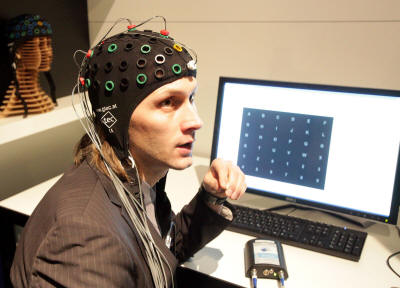|

by Madison Ruppert
August 17, 2012
from
EndTheLie Website
Recovered through
WayBackMachine Website
Spanish version

A brain-computer
interface (BCI)
being demonstrated in
2009
As hard as it is to believe, what many might think is the last
bastion of total privacy, namely, the human mind, is quickly
becoming
just as vulnerable as the rest of our lives with the
invention of mind-reading helmets and
other ways to “hack” the mind.
Now security researchers from the University of California,
Berkeley, the University of Oxford and the University of Geneva,
have created a custom program to interface with brain-computer
interface (BCI)
devices and steal personal information from unsuspecting victims.
The researchers targeted consumer-grade BCI devices due to the fact
that they are quickly gaining popularity in a wide variety of
applications including hands-free computer interfacing, video games
and biometric feedback programs.
Furthermore, there are now application marketplaces - similar to the
ones popularized by Apple and the Android platform - which rely on
an
API to collect data from the BCI
device.
Unfortunately with all new technology comes new risks and until now,
“The security risks involved in
using consumer-grade BCI devices have never been studied and the
impact of malicious software with access to the device is
unexplored,” according to
a press release.
The individuals involved with this
project - which resulted in a research paper entitled “On
the Feasibility of Side-Channel Attacks with Brain-Computer
Interfaces,” include,
-
Ivan Martinovic and Tomas Ros of
the Universities of Oxford and Geneva, respectively
-
along with Doug Davies, Mario
Frank, Daniele Perito, and Dawn Song, all of the University
of California, Berkeley
The findings of these innovative
researchers are nothing short of disturbing.
They found,
“that this upcoming technology could
be turned against users to reveal their private and secret
information.”
Indeed, they used relatively cheap BCI
devices based on electroencephalography (EEG) in order to
demonstrate the feasibility of surprisingly simple and effective
attacks.
The information that can be gained by the attacks is incredibly
sensitive, including,
“bank cards, PIN numbers, area of
living, the knowledge of the known persons.”
Most troubling is the fact that this
represents,
“the first attempt to study the
security implications of consumer-grade BCI devices,” which
makes the success of the attacks that much more disconcerting.
The researchers tested out their
proprietary program on 28 different participants who, while they
were obviously aware that they were cooperating in a study, were not
aware that they were being “brain-hacked,” as it were.
Unfortunately, or fortunately depending on your perspective, the
researchers found,
“that the entropy of the private
information is decreased on the average by approximately 15% -
40% compared to random guessing attacks.”
Or as Sebastian Anthony put it in
writing for
ExtremeTech,
“in general the experiments had a 10
to 40% chance of success of obtaining useful information.”
The researchers leveraged a distinctive
EEG signal pattern known as the
P300 response.
This
brainwave pattern typically occurs
when the subject recognizes something such as a friend’s face or a
tool necessary to complete a given task. Using the knowledge of the
P300 response, the researchers created a program which utilizes a
technique which those who are familiar with typical hacking might
call a “brute force” method.
However, this method is only loosely comparable to the traditional
brute force methods since we’re talking about using a brute force
attack on the human mind. The researchers did this by flashing
pictures of maps, banks, PINs, etc. while monitoring the subject for
any P300 responses.
After they had collected enough data from the subject, they were
able to easily compare the captured information in order to see when
a P300 response was triggered by a certain image.
Thus, this allowed the researchers to discover with surprising
accuracy which bank the subject uses, where they live, and other
information which could potentially be highly sensitive.
The key to capturing this information seems to be making the subject
remain unaware of the fact that they are being attacked either
through specially formulated “games” designed to steal personal
information from the mind of the target or through a false sense of
security engendered by social engineering techniques.
Personally, I find it quite troubling that people could have their
personal information stolen simply by playing what they think
is a normal game controlled by a BCI device when in reality it is a
carefully engineered piece of software designed to pull private data
from the target’s mind.
As Anthony correctly points out,
“Moving forward, this brain hack can
only improve in efficacy as BCIs become cheaper, more accurate,
and thus more extensively used.”
However, Anthony incorrectly states,
“Really, your only defense is to not
think about the topic,” when in reality the P300 response can
occur without consciously “thinking” about the topic.
The response can occur when a picture of
a familiar face or location shows up, even if the individual isn’t
thinking about the familiar person or the location.
While someone could theoretically be on
the defensive in an attempt to minimize their responses, the entire
methodology of the hacker depends on avoiding detection to begin
with.
Therefore, if the target is already consciously on the defensive,
the hacker has failed in their task of remaining in the shadows and
carrying out the attack without the knowledge of the target.
That being said, if programs are created in a clever enough manner,
I seriously doubt that most people would be able to tell that
they’re being actively attacked in order to obtain their most
private and sensitive information.
|

